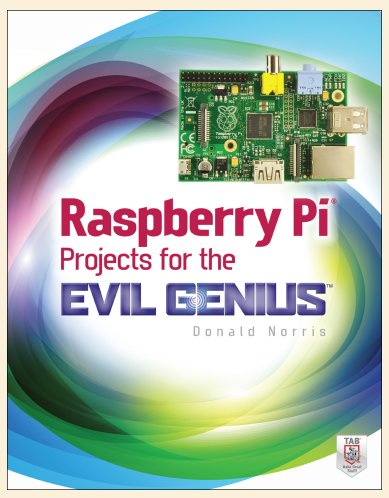E-Book description:
This Raspberry Pi project book is not only about building a series of interesting projects but also about providing an education regarding the underlying project technologies. I am positive that my over-30-years’ experience as a college educator forced me to ensure that readers could not only build the projects but also understand why they function as designed.
Building a successful project is rewarding unto itself, but understanding why and how it functions is far more important. The reader should expect a manifold increase in experience with the Raspberry Pi if a commitment is made to expend the time and energy to complete most, if not all, of the projects. I learned a lot while completing them; sometimes things worked out fine, while other times they were not successful. But that’s the joy of experimenting. As Professor Einstein once stated, “Anyone who has never made a mistake has never tried anything new.” The joy of learning about and building projects is the core concept within this book. I designed and built all of the projects, and along the way gained a lot of knowledge about the Linux OS and how it really shines as an embedded development platform. I will not recap the projects here other than to state that the complexity increases from the book’s beginning to its end. And this is how it should be, as experience and confidence in dealing with Linux and the Python language are progressively gained by proceeding through the projects. Experienced Linux developers should feel free to jump into any of the projects; however, there are useful hints and techniques sprinkled throughout the book, which might be missed by taking a selective approach to reading it. I have also tried to point out the constraints and limitations of the Raspberry Pi as I encountered them when designing and building the projects. Just keep in mind, a $35 computer simply cannot meet all expectations. One disclaimer that I feel is warranted relates to the Python programs. These programs, while fully functional for the respective projects, are probably not in their best form. As I tell my beginning programming students, there are many ways to develop functional programs. Some are better than others—not necessarily right or wrong. With this perspective, I tried to keep the programs simple and to the point, and to avoid any unneeded complexity. All of the book’s projects can be expanded and modified as desired. I strongly recommend that readers do so, as that is one sure way to understand the concepts and bolster skills. The ability to experiment has been described as one of the key attributes that modern employers are looking for in twenty-first century employees.
E-Book Author:
Donald Norris
E-Book Table of Contents:
Preface
Acknowledgments
1 Introduction to the Raspberry Pi
Hardware
Software
Summary
2 LED Blinker Project
Prototype Board
Soldering
Accessing the GPIO Pins
apt-get Command
LED Project
Summary
3 MP3 Player Project
Prototype Connector
Portable Stereo Speaker
Audio File Formats
Hardware Switch Inputs
Thinking in RasPi Time
MP3 Project Requirements
Summary
4 Camera Controller
Project Requirements
Camera Shutter Operation
Electronic Flash
Optoisolator Interfaces
Sound and Laser Modules
Interface Connections
Time-Lapse Function
Summary
5 GPS
Introduction
The Basics of How GPS Functions
The Ultimate GPS Receiver
NMEA Protocol
The gpsd Apps
Summary
6 Earthquake Detector
Introduction
Seismology and Earthquakes
Analog-to-Digital Conversion
Serial Peripheral Interface
Connecting and Testing the MCP3008 with the RasPi
Seismic Data Analysis
Operational System
Summary
7 Home Automation
Introduction
Z-Wave Mesh Network
RasPi and Z-Wave Interface
SSH Login
Open Z-Wave Software
Summary
8 Home Security Controller
Introduction
Webcam Selection
Laser Trip Assembly
Motion Software Package
Webcam Viewing
Laser Trip Program
Additional Sensors
Summary
9 NFC/RFID Reader
Introduction
How NFC Works
Installing libnfc
Hardware Installation
Initial Checkout
Project Program
Future Expansion
Summary
10 1-Wire Weather Station
Introduction
Weather Station Design
1-Wire Protocol
1-Wire Sniffer
Set Up the Weather Station Hardware
1-Wire File System
Viewing the Weather Data
Packet Sniffing
Future Expansion
Summary
11 Local and Remote Logic Controller
Introduction
1-Wire External Control Board
1-Wire File System (owfs) Installation and Configuration
Linux, Hardware, and FUSE
Test Sequences for the 8 Channel I/O Board
Python Test Program
Sniffer Monitoring
Android Remote Control
Testing the Web Server with a Browser
Summary
12 Robotic Car: Part 1
Introduction
Overview
Chassis and Drive Motors
Servos
13 Robotic Car: Part 2
Introduction
Robotic Car Block Diagram
I2C Software
Bluetooth Software
Robot Car Program
Operating the Robotic Car
Future Expansions
Summary
14 Radon Detector
Introduction
Radioactivity and Radon
K2645 Geiger-Muller Counter
Initial Test Configuration
Building a Portable Radiation Detector
Operating the Portable Geiger Counter
Modifications and Expansions
Summary
15 Serving Up Time with an RTC and NTP
Introduction
Real-Time Clock (RTC)
RTC Software
Introduction to the Network Time Protocol (NTP)
Building a RasPi NTP Server
Summary
Index


